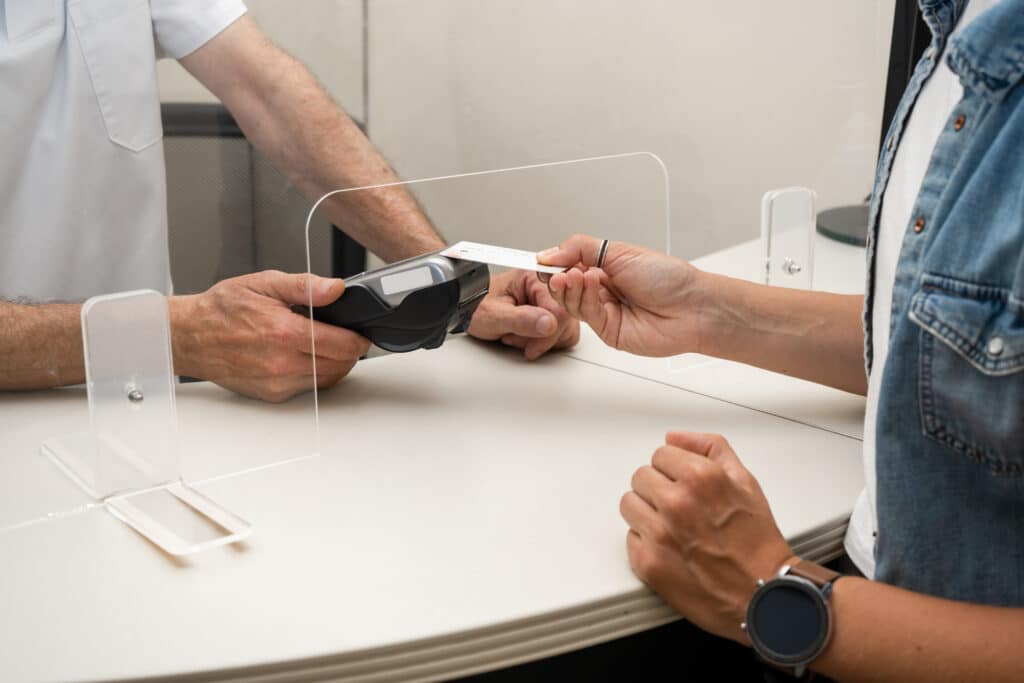If you’re a medical professional who runs their own practice, you know how essential it is to get paid promptly for the services you provide. But typical billing cycles last a month or more, as charges are routed through insurance agencies and can take weeks to arrive with the patient for final payment. That’s why practices looking to shorten their revenue cycle need to look into point of service collections—accepting credit cards or cash right there in the office—which is the most efficient way to get paid quickly and provide your patients with an optimized experience.
With point of service collections, you’ll collect copays from patients right there in the office. This helps you avoid lengthy billing cycles and even makes it more likely for patients to pay altogether. For patients, paying at the time of service is often preferable to receiving a bill weeks or months after the fact, which they can easily forget about.
But adding a system for collecting payments at the point of service isn’t as easy as flipping a switch. It requires a coordinated effort, and even then you won’t be guaranteed to be getting the most out of your new collections routine. But we’re here to help—this article will walk you through the importance of point of service collections and give you ten best practices for getting the most out of them at your practice!
The Importance of Point of Service Collections as a Medical Practice
There are a number of reasons why healthcare providers should use point of service collections to improve their practice management and medical billing. It starts with helping to ensure that patients pay their bills on time, improving cash flow and keeping your practice running smoothly. In turn, this will help your patients avoid late payment penalties or having outstanding bills sent to collections agencies, improving the patient/provider relationship. Remember—when patients are happy, they’re more likely to recommend your practice to others.
Implementing collections at the time of service shouldn’t be difficult, but it does require you to provide additional training for your staff and some education for your patients. With a little effort, you should be able to use point of service collections to make a big impact on your practice.

10 Best Practices for Maximizing Point of Service Collections
Here are ten top tips for maximizing the effectiveness of your point of service collections.
1. Remain polite and professional, and explain charges in full.
When you’re asking for payment, it’s always important to be polite and professional. Additionally, be prepared to explain in detail what services you provided and why payment is due. By doing so, you can ensure that patients understand the services they received and why they need to pay. This can help reduce confusion and frustration and create a positive relationship with your patients, which can lead to better patient care overall. Plus, patients are more likely to pay promptly if they feel like they’re being treated fairly and with respect.
2. Accept multiple forms of payment.
Here’s a simple rule to remember—the more types of payment you accept, the more likely you are to be paid promptly. This is especially true if you’re collecting payments at the time of service, as a patient may only have a limited number of payment options handy. By being flexible about payment types and accepting credit cards, debit cards, checks, cash, and even virtual payments like Apple Pay, you’ll make payment more convenient for your patients. That’s crucial for collecting payments quickly.
3. Always follow up with patients who have outstanding debts.
While collecting payments at the point of service is ideal, it isn’t always feasible. Have a backup plan in place to make sure you don’t miss out on important revenue! If a patient can’t pay at the time of service, you’ll want to route them through your regular medical billing process. This means sending them a bill and—most importantly—following up with them to ensure payments are received.
4. Train your staff for difficult discussions.
It’s important to make sure your staff is prepared to have difficult conversations about payments with your patients. This may seem daunting to your staff at first. After all, no one wants to deliver harsh financial news to a patient who is undergoing important care. But the better prepared your staff members are to have these discussions, the easier things will be. Consider having scripts to follow for sensitive topics, and regularly check with your staff to see if there are areas where they feel more support is needed.
5. Make billing management a front-office responsibility.
Managing the revenue cycle is typically part of the job done by your back office. But if you’re implementing a point-of-service collections program, it could make sense to shift billing as a whole onto your front-office staff. Doing so will help ensure your revenue cycle management doesn’t become a fragmented process, which could lead to mistakes and lost revenue.
6. Be transparent about pricing.
A law passed in 2022 makes transparent pricing the rule in healthcare, citing the important protections pricing transparency gives to consumers. Your practice should embrace transparent pricing not just because of the legal necessity, but because pricing transparency is an easy way to promote faster payments and a shorter billing cycle. When a patient knows what to expect in terms of cost, they can be better prepared to pay at the point of service.
7. Establish patient expectations early.
Pricing transparency is essential, and establishing expectations around costs will help foster a successful patient/provider relationship. When a patient schedules a visit, your staff should be ready to provide an estimate for the amount the patient will be billed. They should also cover the various payment options, and reinforce the idea that payment at the point of service isn’t just possible, but preferred.
8. Offer patient payment plans.
Not every patient is going to be able to afford to pay for their care in one lump sum. Don’t let this become a problem—instead, make it easy for patients to enroll in a payment plan that makes payments bearable for their budget while keeping revenue streaming into your practice. Collecting payments in multiple installments is still collecting payments, and it’s far preferable to allowing a patient’s outstanding debts to go to a collections agency (which typically results in your practice receiving just a fraction of what you were initially owed).
9. Be smart about software.
The easiest way to implement a point-of-service payments solution is to choose an integrated payment processing platform that allows for it right out of the box. Finding the right medical billing software is an important task for any practice, and it’s essential for ones looking to start collecting patient payment up front. You’ll want a solution that makes point of service collections easy, meaning one that offers that as a default option and which will integrate seamlessly into your existing workflow.
10. Take your time making changes.
Managing patient payment properly is critical to providing the best possible patient experience. If you’re about to make a change to your process, even if it’s to introduce a net-positive feature like collecting copay at the time of service, it’s important to manage the change effectively and to not rush things. Take your time and do your due diligence when choosing new software. Make sure your staff are properly trained on any new systems before rolling them out to your patients. Don’t get caught up comparing yourself to your competitors and feeling like you need to rush out a new service. Keep your focus on the end results—a better patient experience, and an improved revenue stream for your practice.

How CollaborateMD Can Help Medical Practice with Point of Service Collections
If you’re ready to experience the convenience that comes with point of service collections, CollaborateMD is here to help. Our cloud-based medical billing software integrates easily with your existing EHR and makes it easy to collect patient copays on the spot.
We’ll help you create a simplified billing processes, avoid complicated workflows, and give you access to the transparent reporting tools you need to optimize your revenue cycle. Want to see how CollaborateMD can change the way your practice works? Schedule a demo with one of our experts today!



